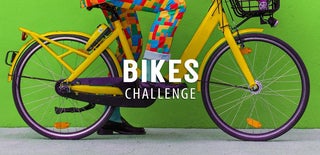Introduction: Mini Cycle
This Instructable describes how to design and create a fully functioning small scale fixed gear wheel Time Trial (TT), racing bicycle for 3D printing.
As an avid cyclist and owner of both fixed gear and freewheel racing bikes I had plenty of examples to work with.
The bike is not based on a specific model but on forms that can exist in practice.
The advantage of a fixed wheel model is simplicity, removing the need for a gear mechanism.
The model is 1/14.26th scale of full size.
The idea behind this design is to produce a functioning model that can be printed flat without any supports in one complete operation. This means the parts are printed in the main horizontally and vertically with no overhangs and hence no supports.
What this means from the point of view of the cycle to be created is that there will be only one rear chain stay and only one front fork blade. On most bikes these elements exist in pairs but real world examples with single sides stays and forks do exist in production.
However, including the other side of the pair on each of these would require the use of supports or printing these separately and fixing together to complete the model. Removing these from the model does not compromise the function and simplifies the process.
The functioning model will have rotating wheels front and rear, movable steerer, chain ring, pedals and drive linkage from the chain ring to the rear wheel. Rather than trying to create sprockets and a chain which although not impossible is impractical for a model of this size. A drive belt (elastic band), with be used and the rear drive and chain ring will be grooved.
Profiling will be applied to the elements to replicate aero functionality. This involves having a rounded tubular form for the downtube, seat tube and the wheels/spokes. Bladed profiles for front fork, chain & seat stay. In this design the seat post is a continuation of the seat tube for simplicity. A separate seat post would require a slot, holes or other attachment.
Supplies
Step 1: Design
The design is created in BlocksCAD
The bicycle consists of the following elements.
Frame
This consists of a single seat stay and chain stay emanating from the profiled one piece seat tube post and meeting at what would the rear dropout. Although in this case axle fixture would be a better term as the wheel does not drop out for removal but is attached at this point.
Front forks and steerer
The front fork is a combined steerer and single blade to which the front wheel is attached at the axle fixture.
Tribars
The tribars are a fully integrated one piece design including aero bars, armrests, base wing and aero pods.
The Tribars are attached to the steerer and both are attached to the frame headset.
Tri spoke wheels
One piece 3 spoke wheels.
The rear wheel has no toothed sprocket but rather an integrated pulley wheel.
Crank Set
A fully functioning two piece crank set with conjoined semi axles using a single bolt.
The chain ring is toothless and replaced with a pulley wheel.
Pedals
Two rotating pedals.
Seat
This attaches to the top of the combined seat tube/post.
Stand
A stand is included into which the rear wheel sits for display.
These elements will be attached using small nuts and bolts apart from the seat and stand which will be an interference fit.
Step 2: Printing
Once the design is complete it is opened in Cura and printing preferences set prior to printing.
Size: 128mm x 107mm x 10.1mm
Infill: 100%
Layer Height: 0.15mm
Base: Brim
Filament used: 28g - 9.41m
Step 3: Assembly
Once printed, the elements are separated and any smoothing applied.
Assembly is designed to be glue less and requiring only 7 bolts to attach the loose elements and one elastic band.
The holes in the wheel hubs may required a little widening with a 2mm drill to allow rotation if printing tolerances impact clearances.
Whilst the holes in the tri-bars, fork, front fork headset, pedals, chain-stay & crank-set require no adjustment.
The first part of the assembly is to attach the pedals to the cranks with 8mm bolts.
These need to be screwed in parallel to prevent binding the pedal preventing rotation.
Secondly, the crank arms are inserted into the bottom bracket facing in opposite directions to each other along the same axis forming a 180 degree angle. The crank arms are keyed to ensure they align in the correct orientation. Once aligned the crank set is secured with an 18mm bolt.
Next the rear wheel is attached with the 12mm bolt tightened to allow the wheel to spin without wobbling unduly.
The tribar is next secured to the fork with a 12mm bolt in the front aligned holes to the steerer and this is attached to the headset by the second hole with another 12mm bolt.
The front wheel to then attached to the fork with an 8mm bolt tightened to allow the wheel to spin without wobbling unduly.
The elastic band is fitted around the crank pulley and the pulley on the rear wheel.
Turning the cranks should cause the wheel to rotate.
If any of the rotating surfaces fail to move freely then they may require further sanding or the bolts will require loosening.
The seat is then fitted to the seat post.
Finally, the rea wheel of the cycle is pushed into the stand to support it in an upright position for display.
Step 4: Display
Now all that remains is to display the model.
If you found this both instructive and interesting please visit the following to help support this and my other projects: Fixed Gear Wheel TT bike

Participated in the
Bikes Challenge












